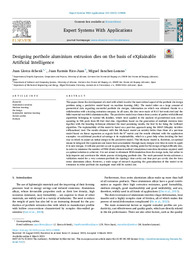Por favor, use este identificador para citar o enlazar este ítem:
https://hdl.handle.net/11000/33438
Designing porthole aluminium extrusion dies on the basis of eXplainable Artificial Intelligence
Título :
Designing porthole aluminium extrusion dies on the basis of eXplainable Artificial Intelligence |
Autor :
Llorca-Schenk, Juan
Rico-Juan, Juan Ramon
Sanchez Lozano, Miguel |
Editor :
Elsevier |
Departamento:
Departamentos de la UMH::Ingeniería Mecánica y Energía |
Fecha de publicación:
2023-03 |
URI :
https://hdl.handle.net/11000/33438 |
Resumen :
This paper shows the development of a tool with which to solve the most critical aspect of the porthole die design
problem using a predictive model based on machine learning (ML). The model relies on a large amount of
geometrical data regarding successful porthole die designs, information on which was obtained thanks to a
collaboration with a leading extrusion company. In all cases, the dies were made of H-13 hot work steel and the
billet material was 6063 aluminium alloy. The predictive model was chosen from a series of probes with different
algorithms belonging to various ML families, which were applied to the analysis of geometrical data corresponding
to 596 ports from 88 first trial dies. Algorithms based on the generation of multiple decision trees
together with the boosting technique obtained the most promising results, the best by far being the CatBoost
algorithm. The explainability of this model is based on a post-hoc approach using the SHAP (SHapley Additive
exPlanations) tool. The results obtained with this ML-based model are notably better than those of a previous
model based on linear regression as regards both the R2 metric and the results obtained with the application
examples. An additional practical advantage is its explainability, which is a great help when deciding the best
way in which to adjust an initial design to the predictive model. This ML-based model is, therefore, an optimal
means to integrate the experience and know-how accumulated through many designs over time in order to apply
it to new designs. It will also provide an aid in generating the starting point for the design of high-difficulty dies,
in order to minimise the number of FEM (finite element method) simulation/correction iterations required until
an optimal solution is achieved. It is not aimed to eliminate FEM simulation from the design tasks, but rather to
help improve and accelerate the whole process of designing porthole dies. The work presented herein addresses a
validation model for a very common porthole die typology: four cavity and four port per cavity dies for 6xxx
series aluminium alloys. However, a wide range of research regarding the generalisation of this model or its
extension to other porthole die typologies must still be carried out.
|
Palabras clave/Materias:
Aluminium extrusion
Machine learning
Die design
Explainable machine learning
Hollow profile
Porthole |
Área de conocimiento :
CDU: Ciencias aplicadas: Ingeniería. Tecnología |
Tipo de documento :
info:eu-repo/semantics/article |
Derechos de acceso:
info:eu-repo/semantics/openAccess
Attribution-NonCommercial-NoDerivatives 4.0 Internacional |
DOI :
https://doi.org/10.1016/j.eswa.2023.119808 |
Publicado en:
Expert Systems with Applications Volume 222, 15 July 2023 |
Aparece en las colecciones:
Artículos Ingeniería Mecánica y Energía
|
 La licencia se describe como: Atribución-NonComercial-NoDerivada 4.0 Internacional.
La licencia se describe como: Atribución-NonComercial-NoDerivada 4.0 Internacional.
 La licencia se describe como: Atribución-NonComercial-NoDerivada 4.0 Internacional.
La licencia se describe como: Atribución-NonComercial-NoDerivada 4.0 Internacional.
.png)
